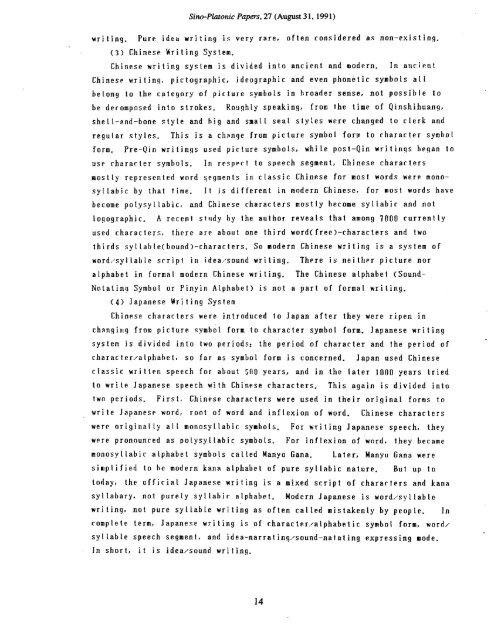Essays on Writing and Language in Honor - Sino-Platonic Papers
Essays on Writing and Language in Honor - Sino-Platonic Papers
Essays on Writing and Language in Honor - Sino-Platonic Papers
Create successful ePaper yourself
Turn your PDF publications into a flip-book with our unique Google optimized e-Paper software.
S<strong>in</strong>o-Plato~zic <strong>Papers</strong>, 27 (August 3 1, 199 1)<br />
writ<strong>in</strong>g. Pure, idea writ<strong>in</strong>g is very rare, often c<strong>on</strong>sidered as n<strong>on</strong>-exist<strong>in</strong>g.<br />
('0 Ch<strong>in</strong>ese <strong>Writ<strong>in</strong>g</strong> Sys tem.<br />
Ch<strong>in</strong>ese writ<strong>in</strong>g system is divided <strong>in</strong>to ancient <strong>and</strong> modern. In ancient<br />
Ch<strong>in</strong>ese writ<strong>in</strong>q, pictographic, ideographic <strong>and</strong> even ph<strong>on</strong>etic symbols all<br />
bel<strong>on</strong>g to the category of picture symbols <strong>in</strong> broader sense, not possible to<br />
be deromposed <strong>in</strong>to strokes. Roughly speak<strong>in</strong>g, from the time of Q<strong>in</strong>shihuang,<br />
shell-<strong>and</strong>-b<strong>on</strong>e style <strong>and</strong> hig <strong>and</strong> small seal styles were changed to clerk <strong>and</strong><br />
regular styles. This is a change from picture symbol form to character symbol<br />
form. Pre-Q<strong>in</strong> writ<strong>in</strong>gs used picture symbols, while post-@<strong>in</strong> writ<strong>in</strong>qs hegan to<br />
USP chararier symbols. In respect to speech segment, Chicese characters<br />
mostly represented word qegments <strong>in</strong> classic Chiaese for most words were m<strong>on</strong>o-<br />
syl labjc by that time. It is different <strong>in</strong> modern Ch<strong>in</strong>ese, for most words have<br />
become polysyllabic, <strong>and</strong> Ch<strong>in</strong>ese characters mostly become syllabic <strong>and</strong> not<br />
logographic. A recent strtdy by the author reveals that am<strong>on</strong>g 1000 currenlly<br />
used characters, there are about <strong>on</strong>e third word( free)-characters <strong>and</strong> two<br />
thirds syllable(bound)-characters. So modern Ch<strong>in</strong>ese writ<strong>in</strong>g is a system of<br />
word,/syllatle scrip! <strong>in</strong> idea.,#sound writ<strong>in</strong>g. There is neither picture nor<br />
alphabet <strong>in</strong> formal modern Ch<strong>in</strong>ese writ<strong>in</strong>g. The Ch<strong>in</strong>ese alphabet (Sound-<br />
Notat<strong>in</strong>s Symbol or P<strong>in</strong>y<strong>in</strong> Alphabet) is not a part of formal writ<strong>in</strong>g,<br />
(4) Japanese <strong>Writ<strong>in</strong>g</strong> System<br />
Ch<strong>in</strong>ese characters were <strong>in</strong>troduced to Japan after they were ripen <strong>in</strong><br />
chnng <strong>in</strong>g from picture symbol form to character symbol form. Japanese wri t <strong>in</strong>g<br />
system is divided <strong>in</strong>to two periods: !he period of character <strong>and</strong> the period of<br />
character/alphahet. so far as symbol form is c<strong>on</strong>cerned. Japan used Ch<strong>in</strong>ese<br />
classic written speech for about 500 years, <strong>and</strong> <strong>in</strong> .the later 1000 years tried<br />
to write Japanese speech with Ch<strong>in</strong>ese characters, This aga<strong>in</strong> is divided <strong>in</strong>to<br />
two pcriods. First, Ch<strong>in</strong>ese characters were used <strong>in</strong> their orig<strong>in</strong>al forms to<br />
write Japanese word, root of word <strong>and</strong> <strong>in</strong>flexi<strong>on</strong> of word. Ch<strong>in</strong>ese characters<br />
were orig<strong>in</strong>al ly a1 1 e<strong>on</strong>osyl labic symbols. For writ<strong>in</strong>g Japanese speech, they<br />
were pr<strong>on</strong>ounced as polysyllabic symbols. For <strong>in</strong>flexi<strong>on</strong> of word. $hey became<br />
m<strong>on</strong>osvl labic alphabet symbols called Manyo Gana. Later, Manyrr Gana were<br />
simplified to he modern kana alphabet of pure syllabic nature. But up to<br />
today, the official Japanese writ<strong>in</strong>g is a mixed script of characters <strong>and</strong> kana<br />
syllabary. not purely syllabic alphabet. Modern Japanese is word,/syllablc<br />
writ<strong>in</strong>g, not pure syllable writ<strong>in</strong>g as often calledmistakenlg by people. In<br />
complete term, Japanese wri t <strong>in</strong>g is of charactar./alphabet ic symbol farm, word/<br />
syllable speech segment, <strong>and</strong> idea-narrat<strong>in</strong>g..sound-natat<strong>in</strong>g express<strong>in</strong>g mode.<br />
. In short, it is idea/sound wri t <strong>in</strong>g.

















